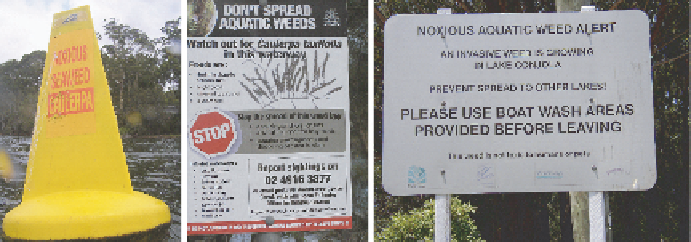Biology Reference
In-Depth Information
Fig. 15.5
Signage used in NSW, Australia to limit further dispersal of
Caulerpa taxifolia
sites newly invaded by
C. taxifolia
(Glasby et al. 2005a). Additionally, when new
infestations are found in NSW, NSW Fisheries establishes fishing closures to pre-
vent hauling or mesh-netting in infested areas under the Fisheries Management Act
of 1994.
15.5.8 PosteradicationSurveys
Eradication only is successful when no living
Caulerpa
is present at a previously
infested location. Although easy to describe, documentation of eradication can be
difficult to obtain based on prevailing currents, water clarity, and epiphytism. In
California, significant effort was devoted to surveying and developing defendable
survey techniques once
C. taxifolia
was no longer located by trained divers. During
both pre- and posteradication monitoring, diver teams followed prescribed parallel
transect lines from GPS coordinates. The grid provided sufficient overlap to mini-
mize missing
C. taxifolia
that was present (Anderson 2005). In Huntington Harbor,
a full survey took 5 days. In Agua Hedionda Lagoon, a full survey of the lagoon
involved swimming more than 500 miles and took 2-3 months (Anderson 2005).
To ensure divers were searching effectively and not just missing plants,
C. taxifolia
mimics (plastic aquarium plants) were deployed in locations unknown to the divers
(Anderson 2005). Survey efficacy varied substantially with water clarity and bot-
tom type. The efficacy study was necessary to estimate how many surveys were
necessary to find every last plant. After 24 months of monitoring with no sightings
of live
C. taxifolia
, but continued sightings of mimics, California deemed eradica-
tion successful in July 2006.
In March 2007, California adopted a new survey protocol for persons applying
for permits to disturb the benthos in areas where
C. taxifolia
was once found.
Before commencing any permitted sediment-disturbing activity, a preconstruction
Caulerpa
survey of the area that covers at least 20% of the bottom that will be
affected must be completed. The affected bottom includes the project footprint,
areas where equipment were stored/moored, areas where vessel prop-wash could

